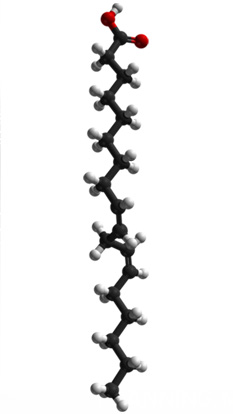







Linoleic acid molecule
Unsaturated fatty acids including oleic acid, linoleic acid or α-linolenic acid suppresses melanogenesis and tyrosinase activity, while saturated fatty acids such as palmitic acid or stearic acid increases it.
Linoleic acid reduces the activity of tyrosinase in melanocytes, while mRNA levels remain unchanged. No evidence of change in TYRP-1 and TYRP-2 protein levels suggest that fatty acids selectively target tyrosinase. This may influence the enzyme’s degradation via a physiologic proteasome-dependent mechanism, altering the tyrosinase protein content in hyperactive melanocytes.
Linoleic acid also influences skin pigmentation by stimulating epidermal turnover and increased desquamation of melanin pigment from the epidermis.
Studies completed to assess the skin lightening capabilities of unsaturated fatty acids, linoleic acid or α-linoleic acid, on UV induced hyperpigmentation of brown guinea pig skin, showed an efficient lightening effect.
It is thought that the unsaturated bonds of these molecules can be easily peroxidized, which in combination with an increase in epidermal turnover, correlate with an inhibitory effect on melanogenesis in vivo.
>
>
>
>
>
>
>
>
>
>
>
>
>
>
>
>
>
>
>
>
>
>
>
>
>
>
>
>
>
>
>
>
>
>
>
>
>
>
>
>
>
>
>
>
>
>
>
>
>
>
>
TOP 20
Hydroquinone
Monobenzyl Ether of Hydroquinone
Azelaic Acid
Kojic Acid
Arbutin
Retinoids
Mequinol
Niacinamide
Soy
Vitamin C
Corticosteroids
Licorice
Hydroxystilbene
Aloesin
Glutathione
Glycolic Acid
N Acetyl Glucosamine
Gentisic Acid
Green Tea
Melatonin
SKIN WHITENING AGENTS A-Z
a-Hydroxyacids
Aloesin
Alpha Tocopherol and Alpha Tocopherol Ferulate
Arbutin
Azelaic Acid
Centaureidin and Methylophiopogonanone B
Gallic Acid and Derivatives
Gingko
Ginseng
Glutathione
Glycolic Acid
Green Tea
Hesperidin
Hydroquinone
Hydroxycinnamic Acid and Derivatives
Hydroxystilbene
Kojic Acid
Licorice
Linoleic Acid
Magnesium Ascorbyl Phosphate
Melatonin
Mequinol
Monobenzyl Ether of Hydroquinone
Mulberry
N Acetyl Glucosamine
N-Acetyl-4-S-Cysteminylphenol
Niacinamide
Retinoids
Salicylic Acid
Soy
Vitamin C

<< Previous: Licorice
Next: Magnesium Ascorbyl Phosphate >>